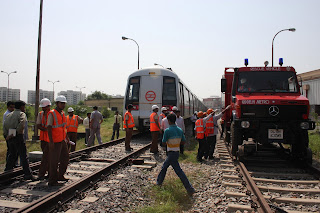Security Beefed up at Metro Stations

The Book Fair has come to an end and the Trade Fair is still some time away. Then why is the queue at the Pragati Maidan metro station extending almost till the main road? “After the blasts and the firing incident in Delhi, security has been beefed up in all the metro stations,” says P D Minz, a Central Industrial Security Force (CISF) employee at Rajendra Place metro station.
The number of CISF personnel deployed at all the metro stations has gone up. “We cannot disclose the exact number of CISF deployed by Delhi Metro Rail Corporation (DMRC) but we have surely increased the number,” says Anuj Dayal, Chief Public Relations Officer at DMRC.
“The patrolling by CISF has gone up on all routes of the metro. The CISF, apart from being responsible for checking on metro stations, also keep traveling on the metro on all the routes and check for miscreants. They also keep checking various corners on metro stations regularly,” says Rajendra Prasad, Customer Care operator at Pragati Maidan metro station.
Since dustbins were used by terrorists for recent bomb blasts, the Managing Director of DMRC, Dr E Sreedharan, has ordered the removal of all the dustbins from the platform areas at all stations as a precautionary measure. “As it is, food and drinks are not allowed inside the metro premises, so we don’t need dustbins,” clarifies Dayal. But an officer at a metro station who didn’t want to be named said that the DMRC is planning to have transparent dustbins at all metro stations.
The security has been increased not only in the metro stations but also in areas around the stations. Rickshaws, which can be seen outside the entrance of all metro stations, have also been told to park a little away from the gate of the stations. Surender, a rickshaw puller outside Patel Nagar metro station says, “Now we can’t stand just outside the gate. If we stand there, then the CISF personnel come and shoo us away. We have to park a little ahead.”
CISF deployed at metro stations also have their own Bomb Disposal Squad and Dog Squad spread over the metro system. “We also have Closed Circuit T elevisions (CCTVs) to monitor movement of people at metro stations. And the new trains that we are procuring will also have CCTV installed inside them,” says Dayal.
Though the DMRC is taking many steps to make sure that the people are safe, not everyone is convinced. Sheena Ahuja, a student of Madhubala College, who travels everyday by the metro says, “The checking is just an eye wash. They just frisk your bag. There is no thorough search of my bag done, ever. I don’t think they are strict enough with the checking.”
It seems that it takes more than long queues and promises to convince people.
 But are all these precautions enough to ensure the people of their safety? “Our business has gone down by nearly 50%. People are no more coming here,” says Ashwini Katpalia, owner of snack corner, Depauls at Janpath. “By turning the dustbins, how can how can you ensure the safety of your citizens. The city will get even dirtier. I mean will the bombers come back and put the bombs in the dustbins again? There is so much crowd that it is difficult to actually keep a track of all such activities. This time it was dustbins, next time it can be anything else.”
But are all these precautions enough to ensure the people of their safety? “Our business has gone down by nearly 50%. People are no more coming here,” says Ashwini Katpalia, owner of snack corner, Depauls at Janpath. “By turning the dustbins, how can how can you ensure the safety of your citizens. The city will get even dirtier. I mean will the bombers come back and put the bombs in the dustbins again? There is so much crowd that it is difficult to actually keep a track of all such activities. This time it was dustbins, next time it can be anything else.” Parshuram, a chaatwala at Janpath recalls that there was panic. “When people came to know that serial blasts were taking place in CP, everybody started running here and there. Everybody shut their shops and went home. There was police all around. Janpath hasn’t seen as much crowd as we used to see before the blasts.”
Parshuram, a chaatwala at Janpath recalls that there was panic. “When people came to know that serial blasts were taking place in CP, everybody started running here and there. Everybody shut their shops and went home. There was police all around. Janpath hasn’t seen as much crowd as we used to see before the blasts.” The never die attitude
The never die attitude
 A wrestler being trained.
A wrestler being trained.


 Trying hands with a dummy
Trying hands with a dummy


